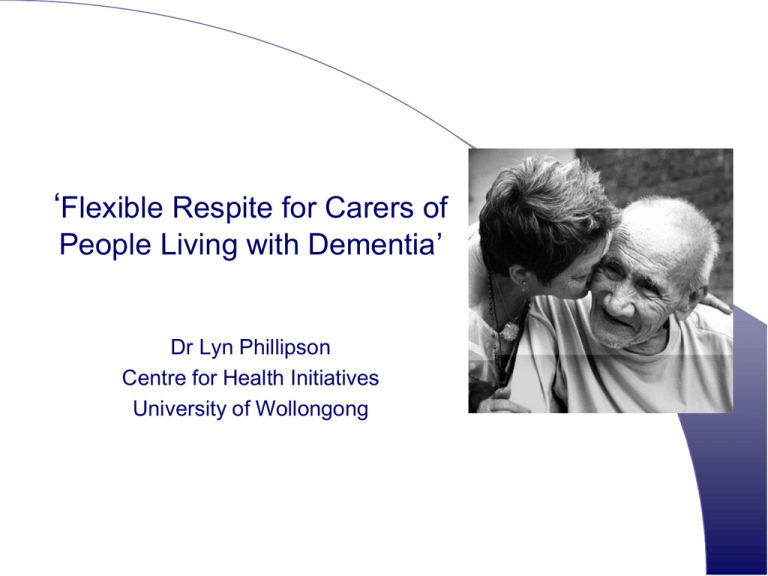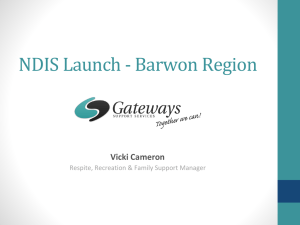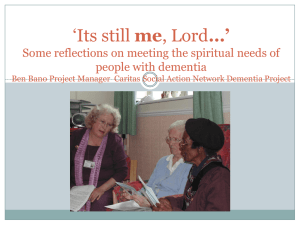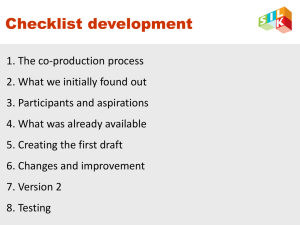Respite - National Respite Association Inc
advertisement

‘Flexible Respite for Carers of People Living with Dementia’ Dr Lyn Phillipson Centre for Health Initiatives University of Wollongong Aims • Caring, Dementia & Respite • Factors associated with use and nonuse of respite • Review the evidence - what is ‘flexible’ respite for carers of people with dementia? • Discussion - policy implications, ways forward Dementia & caregiving • 320, 000 people living with dementia – projected to increase to >900,000 by 20501 • Living with dementia is associated with ageing and institutionalisation – those who live at home do so with the support of a carer2 • Younger people also get dementia3 • Caring for a family member with dementia can have many positive aspects4-5 • However, can also be associated with physical and psychological stresses6-7 - particularly if the caregiver feels trapped7 Respite Respite - An alternative or supplementary care arrangement with the primary purpose of giving the carer: • A short term break from their usual caring role; • Assistance with performing the their caring role, on a short term basis (Dept, of Health, 2014) Respite & caregivers of people with dementia • Respite identified as a critical unmet need8-9 • Enables them to continue role for longer10 • Delays institutionalisation (and associated risks)11 • Reflects community and government preference for living in own home12 Current Respite Program Structure Aged Respite Use – carers of people living with dementia • Carers of people with dementia are more likely than other carers to use respite • However, despite high need, proportion of caregivers of people with dementia using available respite is low • For out of home respite – 2 - 40% using RRC11-13 and 929% using a day centre14-15 • Only 32% with an approval used residential respite (Australia)15 • RRC - Phillipson et al (2013), NSW 13 – 68/113 (60.2%) not using RRC – 66/68 indicated an unmet need Respite non-use • Barriers to the use of respite services are specific to the respite service type • Specific sub-groups of the carer population may be more prone than others to not utilising available care • Strategies to support use need to address both attitudinal and practical barriers to the use of specific services rather than to ‘respite’ in general Phillipson et al, 2013, Health & Social Care in the Community 16 Factors associated with non-use Out of Home Respite Predisposing Spousal caregiver; CALD care recipient Beliefs – Caregiving; Expectations of negative outcomes Low perceived utility (CG & CR) Enabling/ Impeding Low knowledge of local facilities No assistance to navigate Service quality, availability, FLEXIBILITY – don’t meet needs Need CR Behavioural Problems CG disturbance at CR functional problems Phillipson et al, 2013, Health & Social Care in the Community13,16, 17 Non-Use of Out of Home Respite Services Flexible Respite Policy • Flexible Respite Policy(ADHC, 2011) - families and unpaid carers of children, young people and adults with a disability • No current policy regarding respite ‘flexibility’ for people living with dementia and their carers • Difficulties due to the diverse funding sources and programs • New proposed reforms - service amalgamation under a new single program - ‘Assistance with Care and Housing for the Aged’ • Incorporate HACC, CHSP & NRCP (Discussion paper, 2014) • New service groups - (Social Participation) – Social support, centre based day care & (Care Relationships) - Flexible, cottage and emergency respite • ‘Just in time’ - to define a policy on ‘flexible’ delivery under the new reforms Evidence base - ‘flexibility’ in respite for dementia • Alz Australia – Respite Review – Policy Paper 33 – Howe 2013 – Bruen and Howe 2009 – Discussion Paper • Research with carers of people with dementia in Australia – Shanley, 2006; Phillipson et al 2009 -2014; Beattie et al 20122014; Stirling et al 2010-2014 • Iterative Coding by Respite Service type – Day care, Inhome care and Residential Care • 5 domains of ‘flexibility’ : – Location - Timing – Providers - Activities - Funding Flexibility – Day Care Domains of Flexibility Description Service Activities Tailored and person-centred to meet different needs e.g men, CALD, younger onset Social participation – variety of company, not just people with dementia Mental Stimulation – enjoyable, meaningful and stimulating Education - for people with dementia and carers Service Timing Variable e.g. Work hours, morning or afternoon, whole day, after care, before care, vacation care Service Location/Facility Flexible to meet needs of physical disability and behavioural problems BUT not institutional Local/Transport Able to provide care outings e.g. visits to parks, cinemas, gallery Able to provide occasional overnight care Service Provider Trained, Experienced, Creative, Varied Service Funding Flexible use of allocation - holidays, regular day care, all after care Flexibility – In-home care Domains of Flexibility Description Service Location In the persons own home In the carers home In the home of another family member Ability to care for others e.g. grandchildren Service Timing Daytime, night time, one-off, responsive, timely Emergency care Unmet need for night time and overnight care Service Provider Regular, known to family and person with dementia Service Activities Social, Domestic and personal care Education for the carer – insights from ‘in the home’ Service Funding Brokerage of services; consumer directed care; use of own family/friends Residential Care Domains of Flexibility Service Location Residential care services Community house or cottage Destination e.g. holiday respite Service Timing Planned – break Planned – stepping stone Emergency e.g. carer illness – need for ‘rapid response pathways’ Need for support to transition ‘in’ and ‘out’ of care Service Providers Residential Aged Care Providers Cottage Day care centres Holiday Service Activities Person centred - comfort, purpose, social interaction, meaningful engagement Carer participation – ability to be involved/stay/assist (if they want to) Service Funding Current RACF allocations underutilised Call for cashing out of allowance for RACFs for use in other settings Brokerage and trial of consumer directed care Financial subsidy for low income Summary • 5 domains – Location, Timing, Providers, Activities, Funding • Aspects of ‘Flexibility’ varies between different respite service products • Need for diverse responsive services - preferably with a knowledge of the carer and the person living with dementia • Benefit of providers able to work across settings to meet the needs across product types to meet needs for flexibility • Impact of new proposed reforms – separation of assessment and case management functions from service provision? Discussion • New system must be funded & structured to meet carers needs for ‘flexibility’ • However, multiple factors need to be addressed to achieving a mutually beneficial experience for carer and person living with dementia through respite • Also need an integrated mix of strategies to address: – information needs & navigational support – attitudinal & practical barriers – quality of care - staff training, facilities, environment, staff to patient ratios Discussion • Alzheimer’s Australia (2013) – aim of any alternative respite program structure for people living with dementia and their carers: - reduce boundaries between types of respite - provide more choice in regards to type - provide more ‘flexibility’ in responding to needs Thank you for your time and attention Any questions? Dr Lyn Phillipson University of Wollongong lphillip@uow.edu.au References 1. Carbonneau H, Carol C, Desrosiers J. Development of a conceptual framework of positive aspects of caregiving in dementia. Dementia and Geriatric Cognitive Disorders. 2010; 9:327-353. 2. Peacock S, Forbes D, Markle-Reid M, et al. The Positive Aspects of the Caregiving Journey With Dementia:Using a Strengths-Based Perspective to Reveal Opportunities. Journal of Applied Gerontology 2010; 29:640-659. 3. Brodaty, H., & Hadzi-Pavlovic, D. (1990). Psychosocial Effects on Carers of Living with Persons with Dementia. Australian and New Zealand Journal of Psychiatry, 24(3), 351 – 361 4. Mittleman, M. (2006). Improving caregiver well-being delays nursing home placement of patients with Alzheimer's disease. Neurology, 67(9), 1592-1599. 5. Brodaty, H., & Hadzi-Pavlovic, D. (1990). Psychosocial Effects on Carers of Living with Persons with Dementia. Australian and New Zealand Journal of Psychiatry, 24(3), 351 – 361 6. Mittleman, M. (2006). Improving caregiver well-being delays nursing home placement of patients with Alzheimer's disease. Neurology, 67(9), 1592-1599. Brodaty H, Thomson C, Fine M. Why caregivers of people with dementia and memory loss don't use services. International Journal of Geriatric Psychiatry. Jun 2005;20(6):537-546. 7. Runge, C., Gilham, J., & Peut, A. (2009). Transitions in care of people with dementia. A systematic review of the literature. , Canberra: Australian Institute of Health and Welfare, Commonwealth of Australia, 2009 8. Brodaty H, Thomson C, Fine M. Why caregivers of people with dementia and memory loss don't use services. International Journal of Geriatric Psychiatry. Jun 2005;20(6):537-546. 9. Cox C. Findings from a statewide program of respite care: A comparison of service users, stoppers, and nonusers. The Gerontologist. 1997;37(4):511. 10. Petty DM. Respite care: a flexible response to service fragmentation. In: Mace NL, ed. Dementia care: patient, family and community. Baltimore,MD: The Johns Hopkins Press.; 1990: pp. 243± 269. 11. Douglass C, Fox P. Health care utilization among clients with Alzheimer's disease: Public policy implications from the California Alzheimer's Disease Diagnostic and Treatment Center Program. Journal of Applied Gerontology. Mar 1999;18(1):99-121. 12. AIHW. Dementia and the take-up of residential respite care. Canberra: Australian Institute of Health and Welfare, Commonwealth of Australia, 2009. Cat.AUS 124. 13. Phillipson, Magee and Jones (2013). Why carers of people with dementia do not utilise out-of-home respite services. Health and Social Care in the Community. doi: 10.1111/hsc.12030 14. Biegel DE, Bass DM, Schulz R et al. Predictors of in-home and out-of-home service use by family caregivers of Alzheimer's disease patients. Journal of Aging and Health. Nov 1993;5(4):419-438. 15. Zarit, Stephens et al (1998). Stress reduction for family caregivers: effects of adult day care use, Journal of Gerontology, 53B, S267-277. 16. Phillipson, L., Jones, SC and Magee, C (2013). A review of factors associated with the non-use of respite services by carers of people with dementia: implications for policy and practice. Health and Social Care in the Community. Doi: 10.1111/hsc.12036 17. Phillipson, L and Jones, SC (2012). Use of day centers for respite by help-seeking caregivers of individuals with dementia. Journal of Gerontological Nursing. Vol 38, No 4, pp 24-34. 18. Phillipson, L and Jones, SC (2011). Residential respite cares: The caregiver’s last resort. Journal of Gerontological Social Work, 54: 691-711.








